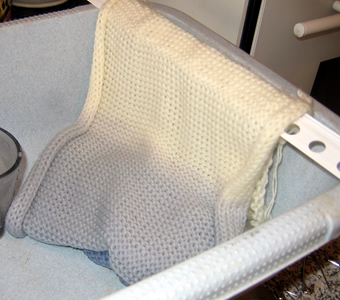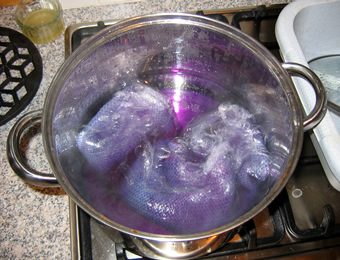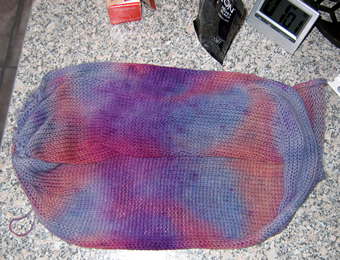« Done - at last | Knitalong Home | Sock blank skein »
Thursday February 19, 2009
Christina: Dye-along
I say dye "along" but so far it's only me - Alison is all set up with her dyes, but is nervous at starting a complex dyeing project currently, as it needs time and space, neither of which are easy to find at the moment. See her non-toxic work with the boys here.
 My project starts with a sock blank from Knit Picks and before I say any more about what I did, I will point you at the Knits Picks tutorials on Sock Blank Dyeing and Gradated Dyeing - read these and do what they say.... Everything I did is most definitely not an improvement on their instructions, and was done purely out of ignorance.
My project starts with a sock blank from Knit Picks and before I say any more about what I did, I will point you at the Knits Picks tutorials on Sock Blank Dyeing and Gradated Dyeing - read these and do what they say.... Everything I did is most definitely not an improvement on their instructions, and was done purely out of ignorance.
If you want inspiration, look at their gallery of projects by others. I think what you can learn here is that the very best (predictable) way to go is fairly regimented stripes. Whatever pattern you choose to paint will not come out on the final socks - apart from anything else it will depend on how many stitches you work with for the sock.
Back to me. I used my Dylon all-purpose dyes in shades of lilac and purple. I have had good results before with Dylon cold water dyes - they are reactive and dye wool well if you use vinegar as the fixer and not alkali. They have stopped making these (and all their niche type dyes) in favour of one all-purpose variety - and these don't work so well with wool. I had an idea as to how I would dip my blank, but I was not satisfied with the pale result.

So I moved on and made up concentrated solutions of the two dyes, and poured them directly on the blank as it lay on cling-flim, and then wrapped up the whole thing in a bundle, which I then immersed in the water bath. I was not too bothered about the colours seeping into one another, so I did not try to steam the package.

Here you can see it all looks promisingly like it will be all shades of lilac. However, I added vinegar to the mix, and I raised the temperature to over 70 degrees C for 30 minutes, and I think that had a significant effect on the colours. When I finally removed the blank from the bath it looked like this. The pink colour seems to have emerged where the blank was exposed to the greatest heat (bottom of the bath).

Since the litmus test itself involves shades of blue turning to pink on exposure to acids, this result may not be too mystifying. The colour combination is perfectly acceptable but not what I was aiming at.
Posted by Christina at 10:30 AM. Category: Dye-along
